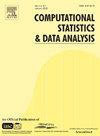Enhancing approximate modular Bayesian inference by emulating the conditional posterior
IF 1.6
3区 数学
Q3 COMPUTER SCIENCE, INTERDISCIPLINARY APPLICATIONS
引用次数: 0
Abstract
In modular Bayesian analyses, complex models are composed of distinct modules, each representing different aspects of the data or prior information. In this context, fully Bayesian approaches can sometimes lead to undesirable feedback between modules, compromising the integrity of the inference. The “cut-distribution” prevents unwanted influence between modules by “cutting” feedback. The direct sampling (DS) algorithm is standard practice for approximating the cut-distribution, but it can be computationally intensive, especially when the number of imputations required is large. An enhanced method is proposed, the Emulating the Conditional Posterior (ECP) algorithm, which leverages emulation to increase the number of imputations. Through numerical experiment it is demonstrated that the ECP algorithm outperforms the traditional DS approach in terms of accuracy and computational efficiency, particularly when resources are constrained. It is also shown how the DS algorithm can be improved using ideas from design of experiments. Some practical recommendations are given for algorithm choice in modular Bayesian analyses.
通过模拟条件后验增强近似模贝叶斯推理
在模块化贝叶斯分析中,复杂模型由不同的模块组成,每个模块代表数据或先验信息的不同方面。在这种情况下,完全贝叶斯方法有时会导致模块之间的不良反馈,从而损害推理的完整性。“切割分布”通过“切割”反馈防止模块之间不必要的影响。直接抽样(DS)算法是近似cut-distribution的标准做法,但它可能是计算密集的,特别是当所需的输入数量很大时。提出了一种增强的方法,即模拟条件后验(ECP)算法,该算法利用仿真来增加插值次数。通过数值实验证明,ECP算法在精度和计算效率方面优于传统的DS方法,特别是在资源受限的情况下。本文还展示了如何利用实验设计的思想来改进DS算法。给出了模块化贝叶斯分析中算法选择的一些实用建议。
本文章由计算机程序翻译,如有差异,请以英文原文为准。
求助全文
约1分钟内获得全文
求助全文
来源期刊

Computational Statistics & Data Analysis
数学-计算机:跨学科应用
CiteScore
3.70
自引率
5.60%
发文量
167
审稿时长
60 days
期刊介绍:
Computational Statistics and Data Analysis (CSDA), an Official Publication of the network Computational and Methodological Statistics (CMStatistics) and of the International Association for Statistical Computing (IASC), is an international journal dedicated to the dissemination of methodological research and applications in the areas of computational statistics and data analysis. The journal consists of four refereed sections which are divided into the following subject areas:
I) Computational Statistics - Manuscripts dealing with: 1) the explicit impact of computers on statistical methodology (e.g., Bayesian computing, bioinformatics,computer graphics, computer intensive inferential methods, data exploration, data mining, expert systems, heuristics, knowledge based systems, machine learning, neural networks, numerical and optimization methods, parallel computing, statistical databases, statistical systems), and 2) the development, evaluation and validation of statistical software and algorithms. Software and algorithms can be submitted with manuscripts and will be stored together with the online article.
II) Statistical Methodology for Data Analysis - Manuscripts dealing with novel and original data analytical strategies and methodologies applied in biostatistics (design and analytic methods for clinical trials, epidemiological studies, statistical genetics, or genetic/environmental interactions), chemometrics, classification, data exploration, density estimation, design of experiments, environmetrics, education, image analysis, marketing, model free data exploration, pattern recognition, psychometrics, statistical physics, image processing, robust procedures.
[...]
III) Special Applications - [...]
IV) Annals of Statistical Data Science [...]
 求助内容:
求助内容: 应助结果提醒方式:
应助结果提醒方式:


